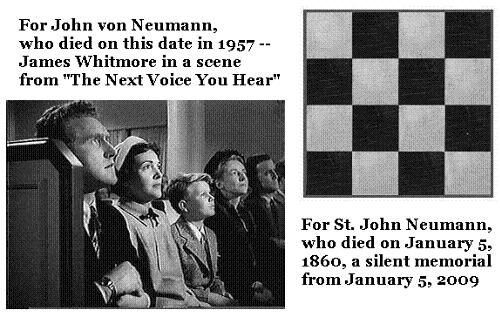Valentine’s Day, the date of the above post, this year was also
Autism Sunday. Here is a flashback to the Autism Sunday of 2015
and two related links —
Friday, February 19, 2021
Autistic Enchantment . . .
Thursday, August 31, 2017
Autistic Enchantments
Log24 on January 31, 2015 —
|
The 1913 puzzle from above, claiming priority —

A more sophisticated puzzle related to the previous post —
Wednesday, April 5, 2017
Autistic Enchantment Continues
See also Autistic Enchantment in this journal.
Friday, July 15, 2016
Autistic Enchantment*
Robert Nye, author of the novel Falstaff , reportedly died
at 77 on July 2, 2016.
Harvey D. Heinz, expert on magic squares, cubes,
tesseracts, etc., reportedly died at 82 on July 6, 2013.
In memoriam —
From the date of Nye's death:
From Nye's book:
From the date of Heinz's death:
* See also a search for the title in this journal.
Sunday, June 14, 2015
Autistic Enchantments
( Continued )
Log24 on January 31, 2015 —Spellbound (continued)The New York Times this morning, in an “… the first known crossword puzzle appeared in See St. Nicholas magazine, November 1874, p. 59 :
|
On that same date …
| The Seattle Times , Feb. 8, 2015, updated Feb. 12—
“… you begin by filling in the missing words Dice, yAhtzee, woN, yahTzee, twicE; The capital letters help to show what comes next, You take the first letter of the first inserted word, |
See also two other dates, June 3, 2015, and June 10, 2015,
in this journal and in the life of the puzzle author.
The date of the puzzle’s answer, Feb. 8, 2015, is also
not without interest.
“Click on fanciful .”
Friday, October 10, 2014
Autistic Enchantment
(Continued from Sept. 3, 2009)

George Steiner on chess:
"At the sight of a set, even the tawdriest of plastic pocket sets,
one’s fingers arch and a coldness as in a light sleep steals over
one’s spine. Not for gain, not for knowledge or reknown, but
in some autistic enchantment, pure as one of Bach’s inverted
canons or Euler’s formula for polyhedra."
— George Steiner in “A Death of Kings,” The New Yorker,
issue dated September 7, 1968, page 133
A related remark from Dudeney:

See also a different context for 16 squares and 322,560 arrangements.
Friday, June 26, 2020
Persons and Operators and Things
| Harvard University Press on a book, Persons and Things, it published on March 31, 2010 Moving effortlessly between symbolist poetry and Barbie dolls, artificial intelligence and Kleist, Kant, and Winnicott, Barbara Johnson not only clarifies psychological and social dynamics; she also re-dramatizes the work of important tropes—without ever losing sight of the ethical imperative with which she begins: the need to treat persons as persons. In Persons and Things , Johnson turns deconstruction around to make a fundamental contribution to the new aesthetics. She begins with the most elementary thing we know: and reveals that their claims upon us are fraudulent. Johnson revolutionizes the method by showing that the inanimate thing exposed as a delusion is central to fantasy life, that fantasy life, however deluded, should be taken seriously, and that although a work of art “is formed around something missing,” this “void is its vanishing point, not its essence.” She shows deftly and delicately that the void inside Keats’s urn, Heidegger’s jug, or Wallace Stevens’s jar forms the center around which we tend to organize our worlds. The new aesthetics should restore fluidities between persons and things. In pursuing it, Johnson calls upon Ovid, Keats, Poe, Plath, and others who have inhabited this in-between space. The entire process operates via a subtlety that only a critic of Johnson’s caliber could reveal to us. |
I prefer the more straightforward insanity of Operators and Things .
Barbara Johnson reportedly died on Aug. 27, 2009. See that date
in other posts now tagged Autistic Enchantment. (That phrase is
the sort of sneering tag one may expect from deplorable academics.)
Wednesday, April 5, 2017
Dem Bones
A note at the end of an article on architecture historian
Christopher Gray in the current online New Yorker —
This article appears in other versions
of the April 10, 2017, issue, with
the headline “Dem Bones.”
"Defeated, you will rise to your feet as is said of Dry Bones .
These bones will rise again." — Agnes Martin, 1973
Accounting for Taste —
Faye Dunaway and Warren Beatty at the Oscars:

Ben Affleck, star of "The Accountant," at the Oscars:

See also Prisoner + Bones in this journal.
Tuesday, June 9, 2015
Princeton Flashback
From The Daily Princetonian on May 29, 2015:
"… well, isn’t that what Reunions is all about?
Making memories?"
"Try to remember the kind of September …."
From this journal on May 29, 2015:
Openings
|
The Dark Horse Rises
Friday, May 29, 2015
Openings
The film "Pawn Sacrifice" reportedly opened in Toronto on September 11, 2014.
See as well Log24 posts of that day and Autistic Enchantment.
Sunday, April 8, 2012
Steiner System
See George Steiner on Autistic Enchantment, as well as…
(Click images for further details.)
This year, Autism Awareness Day was April 2.
Tuesday, November 3, 2009
Levi-Strauss Died…
… on Friday, October 30, 2009 ………
(known to some as “Devil’s Night”)………
according to The New York Times …
…
A search in this journal for “Levi-Strauss” yields various entries, the most recent being “Autistic Enchantment” (Sept. 3, 2009).
Related material:
Today’s New York Times on autism
(A Powerful Identity, a Vanishing Diagnosis)
and Log24 on enchantment.
An instance of the latter (from Feb. 15, 2008):
Door
Step:
“Many dreams have been
brought to your doorstep.
They just lie there
and they die there.”
— Lyricist Ray Evans,
who died at 92
one year ago today
Associated Press –
Feb. 15, 2008
Today in History –
Thought for Today:
disenchantment with truth.”

Postscript of Nov. 3, 2009:
For more confusion, see
the works of Claude Levi-Strauss.
 But according to The Telegraph, Levi-Strauss
But according to The Telegraph, Levi-Strauss
died on Saturday, Oct. 31, All Hallows’ Eve.
According to Le Monde, he may have died
even later, on Sunday, Nov. 1, All Saints’ Day.
Thursday, September 3, 2009
Thursday September 3, 2009
“Music and mathematics are among the pre-eminent wonders of the race. Levi-Strauss sees in the invention of melody ‘a key to the supreme mystery’ of man– a clue, could we but follow it, to the singular structure and genius of the species. The power of mathematics to devise actions for reasons as subtle, witty, manifold as any offered by sensory experience and to move forward in an endless unfolding of self-creating life is one of the strange, deep marks man leaves on the world. Chess, on the other hand, is a game in which thirty-two bits of ivory, horn, wood, metal, or (in stalags) sawdust stuck together with shoe polish, are pushed around on sixty-four alternately coloured squares. To the addict, such a description is blasphemy. The origins of chess are shrouded in mists of controversy, but unquestionably this very ancient, trivial pastime has seemed to many exceptionally intelligent human beings of many races and centuries to constitute a reality, a focus for the emotions, as substantial as, often more substantial than, reality itself. Cards can come to mean the same absolute. But their magnetism is impure. A mania for whist or poker hooks into the obvious, universal magic of money. The financial element in chess, where it exists at all, has always been small or accidental.
To a true chess player, the pushing about of thirty-two counters on 8×8 squares is an end in itself, a whole world next to which that of a mere biological or political or social life seems messy, stale, and contingent. Even the patzer, the wretched amateur who charges out with his knight pawn when the opponent’s bishop decamps to R4, feels this daemonic spell. There are siren moments when quite normal creatures otherwise engaged, men such as Lenin and myself, feel like giving up everything– marriage, mortgages, careers, the Russian Revolution– in order to spend their days and nights moving little carved objects up and down a quadrate board. At the sight of a set, even the tawdriest of plastic pocket sets, one’s fingers arch and a coldness as in a light sleep steals over one’s spine. Not for gain, not for knowledge or reknown, but in some autistic enchantment, pure as one of Bach’s inverted canons or Euler’s formula for polyhedra.”
— George Steiner in “A Death of Kings,” The New Yorker, issue dated September 7, 1968, page 133
“Examples are the stained-glass windows of knowledge.” —Nabokov

Click above images for some context.
Log24 entries of May 30, 2006, as well as “For John Cramer’s daughter Kathryn”– August 27, 2009— and related material at Wikipedia (where Kathryn is known as “Pleasantville”).
Saturday, April 4, 2009
Saturday April 4, 2009
"… in some autistic enchantment, pure as one of Bach's inverted canons or Euler's formula for polyhedra."
pure as one of Bach's inverted canons or Euler's formula for polyhedra."
— George Steiner, "A Death of Kings," in The New Yorker, issue dated Sept. 7, 1968
A correspondence underlying
the Steiner system S(5,8,24)–

The Steiner here is
Jakob, not George.
 See "Pope to Pray on
See "Pope to Pray on
Autism Sunday 2009."
See also Log24 on that
Sunday– February 8:

Tuesday, March 10, 2009
Tuesday March 10, 2009
“Music, mathematics, and chess are in vital respects dynamic acts of location. Symbolic counters are arranged in significant rows. Solutions, be they of a discord, of an algebraic equation, or of a positional impasse, are achieved by a regrouping, by a sequential reordering of individual units and unit-clusters (notes, integers, rooks or pawns). The child-master, like his adult counterpart, is able to visualize in an instantaneous yet preternaturally confident way how the thing should look several moves hence. He sees the logical, the necessary harmonic and melodic argument as it arises out of an initial key relation or the preliminary fragments of a theme. He knows the order, the appropriate dimension, of the sum or geometric figure before he has performed the intervening steps. He announces mate in six because the victorious end position, the maximally efficient configuration of his pieces on the board, lies somehow ‘out there’ in graphic, inexplicably clear sight of his mind….”
“… in some autistic enchantment, pure as one of Bach’s inverted canons or Euler’s formula for polyhedra.”
— George Steiner, “A Death of Kings,” in The New Yorker, issue dated Sept. 7, 1968
“Classrooms are filled with discussions not of the Bible and Jesus but of 10 ‘core values’– perseverance and curiosity, for instance– that are woven into the curriculum.”
— “Secular Education, Catholic Values,” by Javier C. Hernandez, The New York Times, Sunday, March 8, 2009
— Raymond Chandler, The Big Sleep
The Chandler quotation appears in “Language Game,” an entry in this journal on April 7, 2008.
Some say the “Language Game” date, April 7, is the true date (fixed, permanent) of the Crucifixion– by analogy, Eliot’s “still point” and Jung’s “centre.” (See yesterday, noon.)














